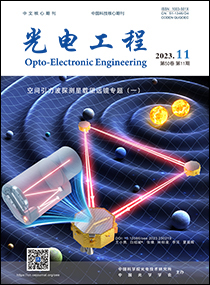2023 Vol. 50, No. 11
Special issue on telescopes for space gravitational wave detection (Ⅰ)
Guest editor: Wang Xiaoyong, Beijing Institute of Space Mechanical and Electrical Engineering; Wen Desheng, Xi'an Institute of Optics and Fine Mechanics, CAS; Rao Changhui, Institute of Opto-Eelectronic Technology,CAS; Zhou Zebing, Huazhong University of Science and Technology; Ye Xianji, Sun Yat-sen University (Zhuhai Campus)
Cover story: Wang X Y, Bai S J, Zhang Q, et al. Research progress of telescopes for space-based gravitational wave missions[J]. Opto-Electron Eng, 2023, 50(11): 230219
The optical telescopes for space-based gravitational wave missions play an important role in the measurement, which both expand the beam going to the far spacecraft and efficiently collect the beam sent from the far spacecraft. The telescope, as part of the interferometric path, directly affects the measurement noise. Compared with the imaging system, the telescope for space gravitational wave observatory not only has high requirements on wavefront quality, but also has extremely high requirements on stray light performance and optical path stability, and the latter two are more challenging. The research progress of the telescope's optical system, optical-mechanical structure, space environment and thermal design, stray light simulation and suppression, and stability measurement is reviewed, which can provide a reference for the development of space gravitational telescope in our country.

-
{{article.year}}, {{article.volume}}({{article.issue}}): {{article.fpage | processPage:article.lpage:6}}. doi: {{article.doi}}{{article.articleStateNameEn}}, Published online {{article.preferredDate | date:'dd MMMM yyyy'}}, doi: {{article.doi}}{{article.articleStateNameEn}}, Accepted Date {{article.acceptedDate | date:'dd MMMM yyyy'}}CSTR: {{article.cstr}}
-
{{article.year}}, {{article.volume}}({{article.issue}}): {{article.fpage | processPage:article.lpage:6}}. doi: {{article.doi}}{{article.articleStateNameEn}}, Published online {{article.preferredDate | date:'dd MMMM yyyy'}}, doi: {{article.doi}}{{article.articleStateNameEn}}, Accepted Date {{article.acceptedDate | date:'dd MMMM yyyy'}}CSTR: {{article.cstr}}

 E-mail Alert
E-mail Alert RSS
RSS


